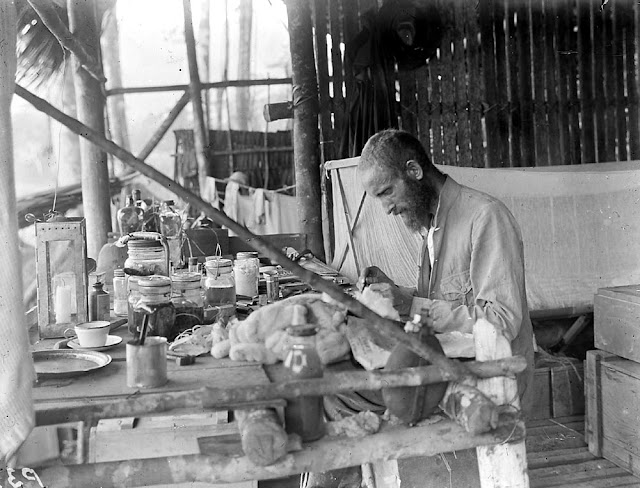 |
| Postcard sent from Pionierbivak in December 1920 via Manokwari (early January 1921) to France, before being redirected to Rome in March 1921. |
When interest in the western part of New Guinea grew at the end of the 19th century, Batavia - modern Jakarta - was faced with an extensive topographical job to map this huge island. Traditionally, the sultan of the small island of Tidore controlled this area after the Sultanate had reached a 'thin' agreement with the VOC in 1660. This agreement stated that "The Papuan areas, or similar islands, all belong to the King of Tidore." The VOC closed this deal with the Sultan of Tidore without having any basic knowledge of the enormous archipelago (approx. 19x times the size current area of the Netherlands, more than 2x the size of Germany). Only a few journeys were endeavored by the VOC to ensure that no illegal clove growers were active in this vast area. When it turned out that this was not the case, indifference to New Guinea rose to a degree which bordered on contempt, and this remained to be the case in the centuries that followed.
At times, Batavia feared that other colonial powers might be interested in this unexplored country. That this was a well-founded fear is evident from the efforts of the British Captain John Hayes, who claimed New Guinea for Great Britain in 1793 and founded a small stockade fortress which he called Fort Coronation. It took its occupiers three years - until 1795 - to abandon. Later Manokwari was built on this spot.
 |
| Manokwari in 1920 |
Rather startled by this "surprise attack" by a British merchant and later in the 19th century by the Scramble for Africa, Batavia resolved to gradually colonize the area. It took until 1897 however before the colonial government decided to do so. In this year, two districts were formed: Northern New Guinea with Manokwari as capital and West and South New Guinea with Fakfak as capital. It was believed that the need for (limited) Dutch rule would also limit the unbridled power of the Tidorese sultan. Until the beginning of the 20th century, the monarch regularly held (illegal) slave raids in the Geelvinkbaai to obtain cheap manpower for his plantations.
In order to thoroughly explore the area, Batavia sent various military expeditions to the yet unknown heartland of New Guinea to colourize this white spot on the map. From 1903 scientific expeditions were also ventured. One of these scientific expeditions is known as the Central New Guinea Expedition of 1920, which aimed to reach the Wilhelmina Summit (now Puncak Trikora) in the central mountain range. In general, the scientific team also wanted to know which (unknown) peoples lived in the area between the so-called Meervlakte and the central ridge. In addition, five scientists focused on issues such as native flora, fauna, geology, etc.
 |
| Pionierbivak on the Mamberamo river is located in the most northwards pointing tip of the main body of West New Guinea (excluding the large Bird's Head Peninsula to the west). |
The Central New Guinea Expedition started in late January 1920 after the entire crew had gathered in Manokwari. From there they sailed about 400 km east before they entered the mouth of the mighty Mamberamo river on the 2nd of February. A military expedition had already explored this river and its headwaters in 1914 and had established some camp sites. A fascinating account (in Dutch) of this military expedition is available online: https://www.gutenberg.org/files/20167/20167-h/20167-h.htm.
 |
| The bend in Mamberamo river near Pionierbivak |
The journey of this postcard also starts in Pionierbivak. Although philatelic in nature, I am not aware of any other postal (value) item sent from Pionierbivak, let alone an item sent from another bivouac. The expedition maintained a regular freight link across the river and sea with Manokwari. The card was sent by the expedition's zoologist, Dr. W.C. van Heurn. W.C. van Heurn (1887-1972) was of noble descent and carried the title of Jonkheer (comparable with squire in English). His younger brother had studied zoology as well and was active in the Sultanate of Deli on Sumatra. W.C. van Heurn has been described by the famous biologist and author Stephen Gould as a "taxonomist's taxonomist". Van Heurn was a keen collector (and hoarder) of 'ordinary' (i.e. not rare) species such as the European Mole and Grove Snail. The Dutch Museum of Natural Science - Naturalis - still houses Van Heurn's collection in a wide variety of jars. Specialists often discovered new species in Van Heurn's diverse collection and no less than 38 species has been named after our author.
The addressee was a Frenchman who often asked Van Heurn to send him cards. The postcard was probably written in early December 1920 but was not postmarked in Manokwari until (1) 4 (?) January 1921. Upon arrival in France in March (?) 1921, the postcard was forwarded to Rome.
 |
| The zoologist and writer of the postcard - W.C. van Heurn. This photograph was taken inside his hut in Pionierbivak. He probably wrote this very postcard at this desk. |
 |
| The reverse side of the postcard with written 'Pionier-bivak' and Dec. 1920. The rather formal message was written in French. |
1st update: 7th of April 2021 - new photo, text additions Van Heurn






































